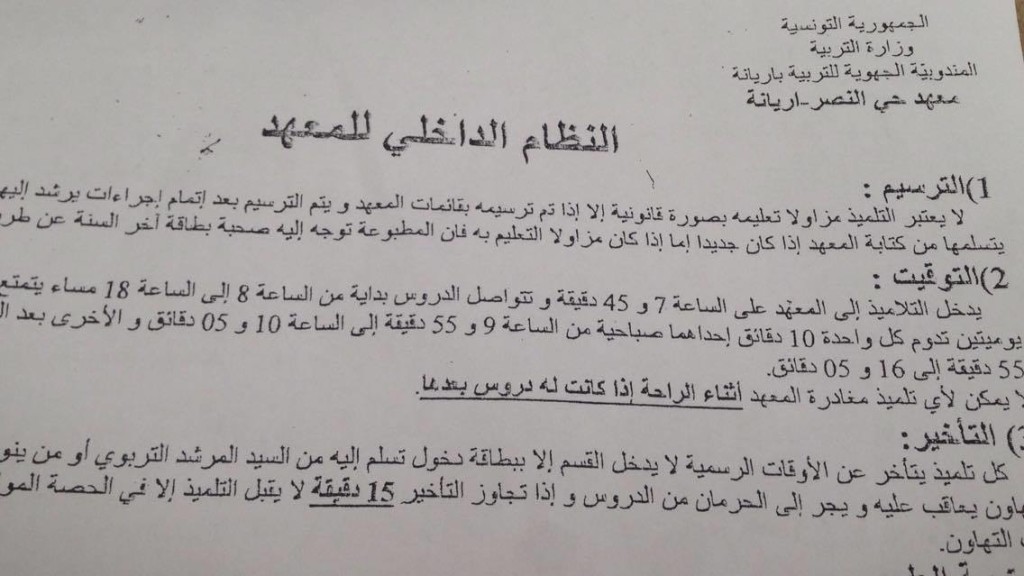The Tunisian Constitution of 2014 stipulates in its article 21: “Citizens are equal in rights and duties. They are equal before the law without any discrimination.
The State guarantees citizens the individual and collective rights and freedoms. He ensures the conditions for a decent life ”.
Tunisians had to be refused all discrimination between citizens, almost four years of battles, demonstrations, cries, struggles so that this principle of equality of citizens was inscribed in the new Constitution.
However, it is clear that despite the vote of this constitution, he actually persists in our daily life of inequalities and injustices which tend to worsen. The separation of students according to their gender and the requirement of wearing an apron or a uniform in schools or high schools by girls only are an illustration.
Formerly, Tunisian schools and high schools were required wearing the apron by all the students. At the time, the apron attached the student to an educational space, kept clean clothes, and above all allowed to erase the differences in social classes between the students and put them all on the same foot of equality.
Then, over time, this requirement of the deck concerned more and more girls only. The question that arises and essential is: why girls? Why this injustice?
Why an apron for girls and not for boys?
This inequality is not sufficient, certain high schools, like the Ennasr high school, have seen fit to accentuate it by demanding girls that they wear a uniform and that they are neither attractive nor coquettes. (Article 10 of the internal regulation of this high school).
Why then?
Why only girls have the right to be flirtatious? What are we afraid of? What do they attract males?
Why don’t we ask for the boys the same? Can’t they also be pretty, have a pretty hairstyle, a pretty outfit, being attractive? So why?
Does this mean that a girl is perceived as an object of desire to hide? Isn’t she a person? So from childhood and adolescence, we want to instill in these young people that a woman is a “3awra” desirable to hide and that a young boy is a being who cannot control his impulses? Wouldn’t that be an infringement of their children’s rights?
In reality, we encourage a pedophile look at the little girl and the teenager and unfortunately it becomes more and more common in Tunisia. It is enough to remember the reaction of the Gafsa child protection delegate in the case of the young 12 -year -old teenager who was recently engaged. The role of the school is however to combat the spread of the violation of children’s rights and not to strengthen and justify it.
These internal regulations are unconstitutional since it affects the rights of the child, the rights of women, equality between citizens and citizens and the principles of education of a civil status.
If the reasons for wearing an apron are always belonging to an establishment, cleanliness and suppression of social disparities, this must concern students of both sexes in the same way. Boys’ clothes also have to remain clean and can be very expensive, and therefore accentuate social inequalities between comrades.
For example, in countries that adopt this unique school uniform system such as Great Britain, Egypt or India, students of both sexes are concerned.
If this apron or uniform meets other criteria or other requirements, what are they? And why would these criteria only concern girls and not boys?
In addition, why are the parents of girls an additional expense that the parents of the boys are not forced?
In this Ennasr high school for example, 25 dinars are claimed per uniform. The parents of the girls will have to pay, in addition to all the expenses of school supplies, notebooks, books … 25 dinars for the purchase of an apron. If sisters frequent this same establishment, this will make 25 dinars per girl multiplied by the number of sisters. But still nothing for the parents of the boys. The parents of girls are therefore penalized compared to the parents of boys. For what? Another inequality between parent citizens and injustice.
For a real justice, and an equality between citizens, it is necessary either to impose a uniform on all the students or to impose any and this, whatever their gender!
Submitting the only girls to the obligation to carry an apron or uniform is therefore unconstitutional. These provisions of the internal regulation of the high school did not comply with the principle of equality between citizens, neither with regard to sex, nor with regard to the imposition of costs relating to the apron to a single category of parents.
In addition, article 46 of the Constitution stipulates: “The State undertakes to protect the acquired rights of women and works to strengthen and develop them. The State guarantees equal opportunities between women and man as to access to all responsibilities and in all areas. The State works to carry out parity between women and man in elected assemblies. The state takes the necessary measures in order to eliminate violence against women. “
In addition to this clothing segregation cited above, we observe that certain establishments operate another segregation which has not existed for decades in our schools and high schools for decades: the physical separation of girls and boys. Increasingly, these students are no longer mixed in classrooms, they are separated according to their sex, on the one hand, on the other hand.
From these two physical and clothing segregations, what are we teaching children? Quite simply that there is a difference between them, that they are not equal. We give them the wrong example. We cultivate discrimination and machismo from an early age. Instead of instilling in them noble values, boys are told to despise women and to consider it as an object. Little by little, we start to change mentalities.
It is frightening to see that there is a step back. Mixed education has been a right acquired for decades in Tunisia. By what right do we want to return to the separation of the sexes? By what right to return to this acquired right? The State is committed to the constitution to protect the acquired rights of women, how can it tolerate that in public schools we come back to this right?
If we tolerate today a return to a acquired right, what will it be tomorrow? Lycées for boys and high schools for girls? And then schools for little girls and schools for little boys? So then? School programs for boys and school programs for girls? And afterwards, we will gradually remove from the girls’ program, the materials that are useless for their roles of wife and mothers and will be replaced by cooking, sewing and embroidery lessons? And later, will we keep the girls at home? After all, why studies, they will become complementary wives and mothers, they do not need to know math, literature and sciences …
In summary, this is a quadruple stigma perfectly unconstitutional: segregation of the sexes, an inequality compared to boys, an additional cost for the parents of girls and a return to a acquired right! The state supposed to respect the Constitution is the first which violates it.
In addition to all this we format the spirits and later these young boys, when they become adult men, will always believe they are superior to women. And the cycle continues!
The question is how many establishments act in this way? Is this an isolated case or are they numerous in this case?
What does the Ministry of National Education do against these actions do? Isn’t there control of the internal regulations of these establishments? What is the women’s business ministry doing? Is it aware of this discrimination between the two sexes?
Neila Driss











